Lost racecourses: How UK housing boom killed city venues
- Published
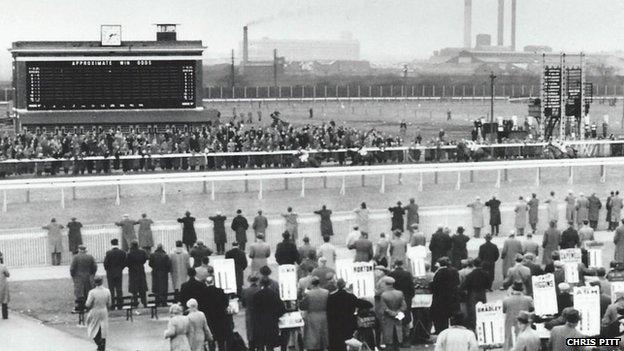
Bromford Bridge racecourse in Birmingham had its own station and special buses ran from the city on race days
Racecourses that once attracted tens of thousands of people now lie beneath airport runways, university campuses and housing estates. It is now 50 years since Birmingham's Bromford Bridge course shut and it is one of many that vanished thanks to a housing boom and the lure of developers' money.

Bromford Bridge, Birmingham
First race: 14 June 1895
Last race: 21 June 1965
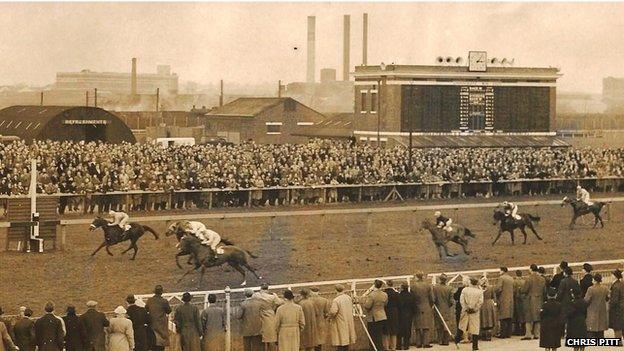
The course once boasted the record for the longest continuous bar in the whole world
Reminders the Bromford Estate in Birmingham was built on the site of a racecourse can be found in the street names - Reynoldstown Road, Haydock Close, Doncaster Way, and, most obviously, Arkle Croft.
During its post-war peak people flocked to the course, which was only five miles (7.2km) from the city centre.
Racing journalist and historian Chris Pitt, who wrote the book A Long Time Gone about the UK's lost racecourses, was 12 when the course closed.
"It had its own railway station or you could catch buses from [the city centre] direct to the course - that's what made Bromford Bridge so much more popular and accessible.
"They built a big bar in the middle of the course which held the record for the longest continuous bar in the whole world - at 334ft (102m) it beat a working man's club in Victoria, Australia.
"When the pop boom started in the 1960s there was a natural mound in the centre of the course, and they used to have bands there - I remember seeing groups like The Swinging Blue Jeans."
Neither the bar nor the music could save the course when Birmingham Corporation eyed the 180-acre site as somewhere to build an estate of 1,900 homes as part of its slum clearance programme.
The corporation paid £1,250,000 for the site, £21.5m in today's money.
Hurdles were replaced by high rise tower blocks and a housing estate, though the parade ring survives as a circular pathway around a green.
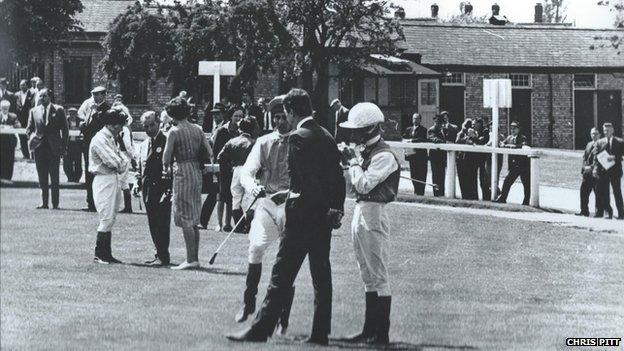
The paddock at Bromford Bridge racecourse, Birmingham

Alexandra Park, London
First race: 30 June, 1868
Last race: 8 September, 1970
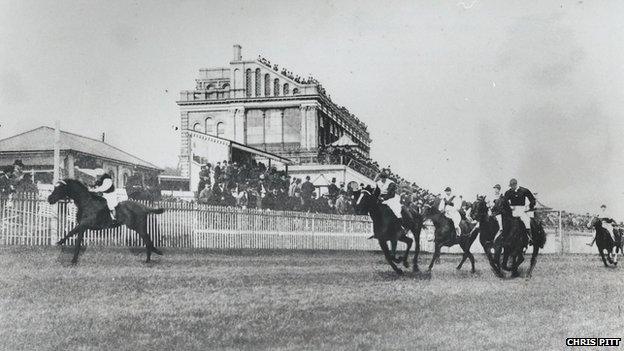
Racing at Alexandra Park, London - the London Gold Cup 1899
There was once a racecourse only seven miles (11km) from the centre of London, a course so loved by racing pundit John McCririck he wants his ashes to be scattered there.
"I always say that part of my soul died when they closed it in September 1970," he said.
McCririck said the racecourse, also known as "The Frying Pan" due to its shape, had a unique atmosphere.
"One of the great advantages was that nearly all the starts took place in front of the stands.
"You could hear the jockeys shouting and the starter trying to control them, and there was the smell of fish and chips and burgers - it was a magnificent evening out - there is nothing quite like Ally Pally."
Many jockeys did not share his enthusiasm - Willie Carson called the course "dangerous" to both horses and riders.
But during its post WWII peak, crowds of 10,000 and more would turn out for evening meetings.
Those kind of crowds were a distant memory by the 1970s - with just 2,749 punters turning up for the last meeting.
"I fear it's too late [to bring back racing] though the outline of the course is still there," John McCririck said.
"But I've told the Booby, my wife, my ashes are to be scattered where the furlong pole was."
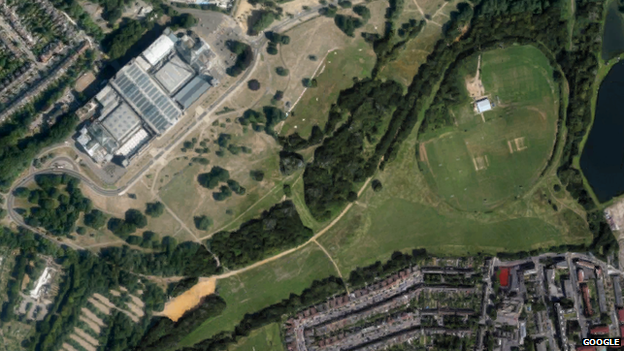
The Alexandra Park track was nicknamed "The Frying Pan" as its long straight was joined to a tight circuit

Castle Irwell, Salford
First race: 26 May 1847
Closed: 1867 - 1896 - racing was held at New Barns, Salford, now the site of Media City
Reopened: Easter 1902
Last race: 9 November, 1963
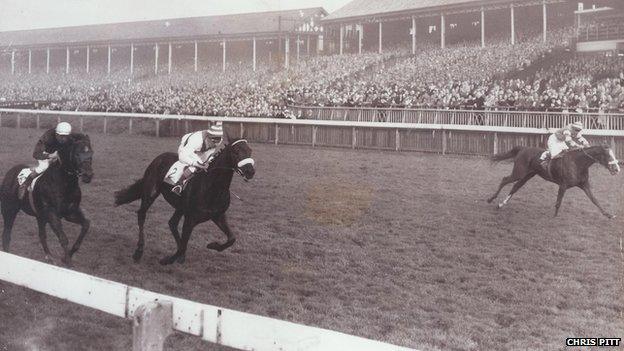
The final November handicap at Manchester Racecourse in 1963
The Castle Irwell course lay in a bend of the River Irwell, which made it so notorious for fog that comedians joked about it in their acts.
When Les Willis was in his early teens he lived in one of the roads leading to the course.
"There were thousands of people walking down our road - the chip shop at the end used to serve sandwiches in the morning and chips in the evening, and they put out tables and chairs in the street for people to use."
Off-course betting was illegal at the time, and he also recalls the backstreet bookmakers plying their trade, with a lookout watching out for the police.
"They were always known as 'uncle', and people would say 'I'm just going to see uncle' when they were off to place a bet.
"It was always the lookouts who ended up in court, and the bookies would go along and pay the fines for them."
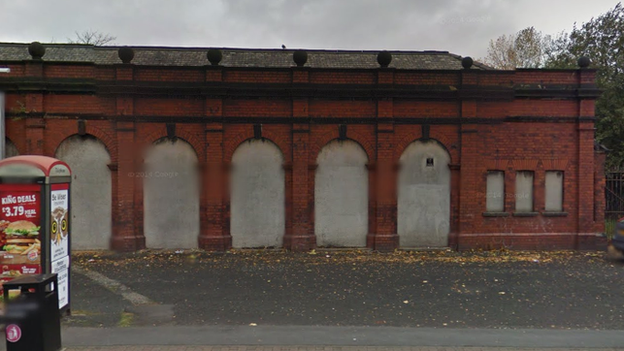
The bricked-up turnstiles to Manchester Racecourse are still visible near a bridge over the River Irwell
The future of the course seemed secure when a new stand was built in 1962, but a year later it was closed.
Castle Irwell too fell victim to the building boom, developers making an offer that for the land that could not be refused.
Just over 20,000 people turned out for the last day of racing.
But the houses never got built and the former racecourse is now part of the University of Salford, with its new stand metamorphosing into a student bar.
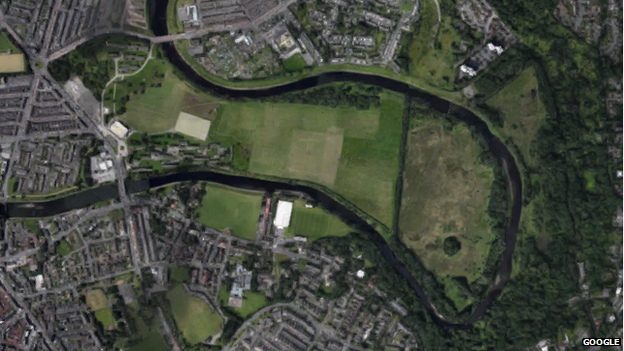
The racecourse was actually in Salford, in a loop of the River Irwell
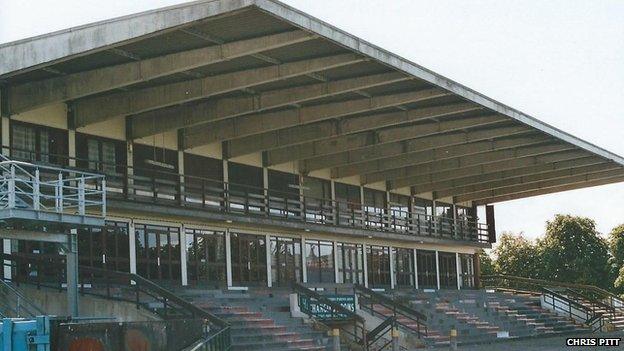
A new stand was opened at Manchester Racecourse only a year before it closed, and is now part of Salford University

Hurst Park, Surrey
First race: 19 March 1890
Last race: 10 October 1962

The finish of the Richemont Stakes at Hurst Park
Hardly a trace remains of one of the most successful racecourses of the post-war period - Hurst Park, on the banks of the River Thames, near Hampton Court, in Surrey.
Although the course was still profitable and popular with both jockeys and punters, it was also on prime building land and in 1962 the owners decided to sell it to a developers for £905,000.
"Losing Hurst Park was a great loss but at the end of the day it's about market forces," said McCririck.
After the last race a bookie hung a wreath on the finishing posts with a card saying: "With sincere memories of a friendly racecourse from all race goers."
The turf from Hurst Park, famed for its quality, was bought by Ascot for its new National Hunt course.
And one of the stands was bought by Mansfield Town FC and transported the 150 miles (240km) to their Field Mill ground.
The most visible sign that racing once took place are the impressive brick gate posts on Graburn Way, which was closed on race days as the seven furlong start ran across it.

Gates across Graburn Way were closed when racing was taking place at Hurst Park

Gatwick racecourse
First race: 7 October, 1891
Substitute Grand National races run on; 24 March 1916 (The Racecourse Association Steeplechase), 21 March 1917 (The War National Steeplechase), 21 March 1918
Last race: 21 April 1948

Racing at Gatwick - the Clayton Selling Chase
Nowadays the only visible reminder that there was racing at Gatwick is the Flying Horse pub in South Terminal.
Yet the racecourse hosted a substitute Grand National three times during WWI, when the Aintree course in Liverpool had been turned into an Army base.
The last of the "Nationals" was won by Ernie Piggott, grandfather of the famous jockey Lester Piggott.
There was already an aerodrome next to the racecourse by 1936, and with the outbreak of WWII the rest of the racecourse was requisitioned for flying.
There was only one post-war meeting, in 1948, which attracted a crowd of 20,000.
Any trace of the racecourse vanished during an £8m redevelopment of the airport in 1958.
However the bandstand does survive - in the town centre of nearby Crawley.
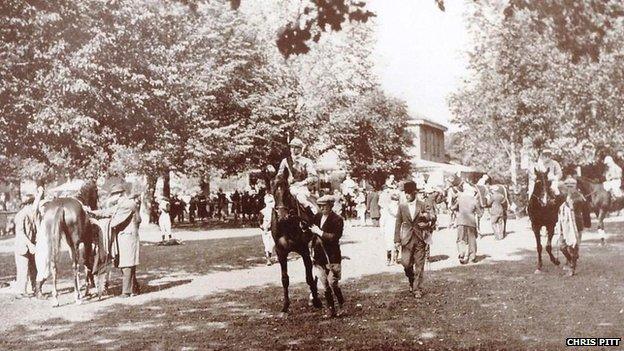
The paddock at Gatwick racecourse
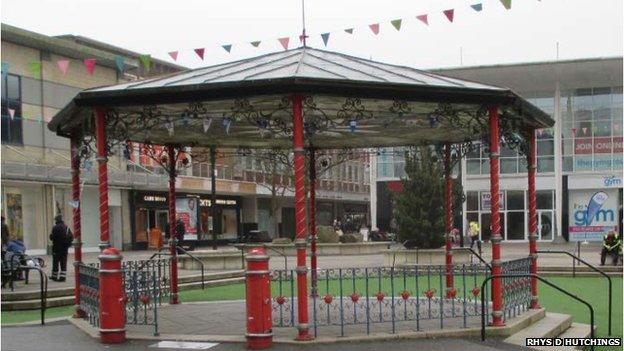
The former bandstand from Gatwick racecourse is now in Crawley town centre

- Published24 June 2015
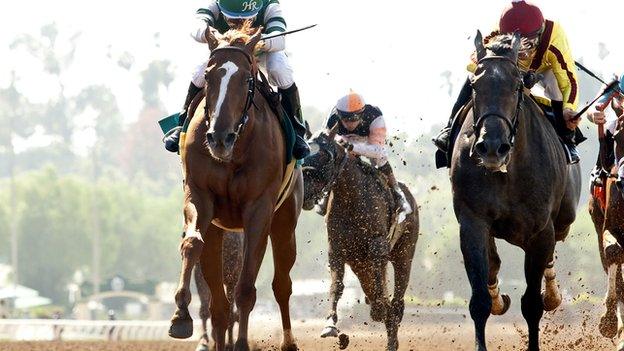
- Published13 August 2010